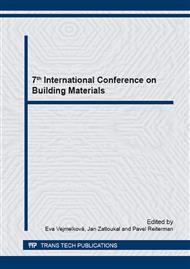p.151
p.155
p.161
p.167
p.173
p.179
p.185
p.191
p.197
Reinforced Cement Composites – Effect of Hybrid Fibres on Selected Properties
Abstract:
In this article selected properties of a glass and polypropylene fibre reinforced cement composite materials are studied. They are determined either after preceding thermal treatment or during thermal loading. Basic physical properties (in concrete terms bulk density, matrix density and open porosity), mechanical properties (in concrete terms tensile strength and bending strength) are determined after subjecting the specimens to the pre-heating temperatures of 600°C, 800°C and 1000°C. The linear thermal expansion coefficient is measured directly as functions of temperature up to 1000°C. The critical temperature for the glass and polypropylene fibre reinforced cement composite when most properties are worsening in a significant way is found apparently 500°C.
Info:
Periodical:
Pages:
179-183
Citation:
Online since:
July 2015
Authors:
Keywords:
Price:
Сopyright:
© 2015 Trans Tech Publications Ltd. All Rights Reserved
Share:
Citation:


